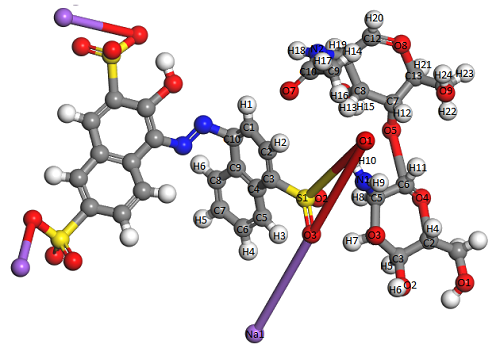
BOMD study on the reaction among one amaranth dye molecule and one chitosan repetitive unit
Abstract
The interaction between the reactants formed by a repeating unit of chitosan (adsorbent) and an amaranth dye molecule (adsorbate) is calculated using Born Oppenheimer Molecular Dynamics (BOMD) to determine possible adsorption. The attack of the adsorbent to the adsorbate is oriented between NH2 and OH of the functional group of C14H24N2O9 chitosan repetitive unit and the functional group of SO3Na sodium sulfonate dye. The electronic effects in the calculation of the dynamics are useful to determine the way these molecules interact. In the first model, it is observed the breakage of a sodium-oxygen bond and another of sulfur-oxygen, belonging to the dye molecule with a reorganization of hydrogens in the chitosan repetitive unit functional group. This shows that there are changes in the site where dye adsorption is predicted on chitosan assuming that the molecules are at neutral pH. For the second model it is observed that the collision of the dye molecule shows repulsive effects by the chitosan repetitive unit forming a deviation angle less than 90°. For this study, DFT was used with exchange and correlation using DZVP basis set function.
Full Text:
PDFReferences
- G. Zhang, Y. Ma, Mechanistic and conformational studies on the interaction of food dye amaranth with human serum albumin by multispectroscopic methods, Food Chem, 2013a, 136. 442-449.
- O. Anjaneya, S. Shrishailnath, K. Guruprasad, A. Nayak, S. Mashetty, T. Karegoudar, Decolourization of amaranth dye by bacterial biofilm in batch and continuous packed bed bioreactor. Int. Biodeter. Biodegr, 2013, 79, 64-72.
- I. Guerrero-Coronilla, Morales-Barrera, T. L. Villegas-Garrido, E. Cristiani-Urbina, Biosorption of amaranth dye from aqueous solution by roots, leaves, stems and the whole plant of E. crassipes. Environmental Engineering and Management Journal, 2014, 8, 1917-1926.
- I. Guerrero-Coronilla, L. Morales-Barrera, E. Cristiani-Urbina, Kinetic, isotherm and thermodynamic studies of amaranth dye biosorption from aqueous solution onto water hyacinth leaves, Journal Environmental Management, 2015,152, 99-108.
- V. Gupta, R. Jain, A. Mittal, T. Saleh, A. Nayak, S. Agarwal, S. Sikarwar, Photo-catalytic degradation of toxic dye amaranth on TiO2/UV in aqueous suspensions, Mater. Sci. Eng. C, 2012, 32,12-17.
- Y. Zhang, T. Gan, C. Wan, K. Wu, Morphology-controlled electrochemical sensing amaranth at nanomolar levels using alumina, Anal.Chim.Acta, 2013b, 764.53-58.
- C. Chen, J. Chang, A. Chen, Competitive biosorption of azo dyes from aqueous solution on the template crosslinked-chitosan nanoparticles, Journal of Hazardous Materials, 2011.185, 430-441.
- A. Chen, S. Chen, Biosorption of azo dyes from aqueous solution by glutaraldehyde-crosslinked chitosans, Journal of Hazardous Materials, 2009,172, 1111-1121.
- G. Crini, P. Bador, Application of chitosan, a natural aminopolysaccharide, for dye removal from aqueous solutions by adsorption processes using batch studies: A review of recent literature, Progress Polymer Science, 2008,33, 399-447.
- E. Guibal, T. Vincent, J. Roussy, Interaction of chitosan with metal ions: from environmental applications to the elaboration of new materials, Advanced Materials Research,2009, 71-73, 519-526.
- Bernardin Jr, FE. Experimental design and testing of adsorption and adsorbates. In: Slejko FL, editor. Adsorption technology: a step-by-step approach to process evaluation and application. New York, 1985. p. 37-90 [chapter 2].
- R. Kumar MNV. A review of chitin and chitosan applications. React Funct Polym 2000, 46:1-27.
- S. Harry, The theory of coloration of textiles. In: Johnson A, editor. Thermodynamics of dye adsorption. 2nd ed. West Yorkshire, UK: Society of Dyers and Colorists, 1989, p. 255.
- G. Crini, P. Bador, Application of chitosan, a natural aminopolysaccharide, for dye removal from aqueous solutions by adsorption processes using batch studies: A review of recent literature, Progress Polymer Science, 2008,33, 399-447.
- E. Guibal, P. McCarrick, J.M. Tobin, Comparison of the adsorption of anionic dyes on activated carbon and chitosan derivatives from dilute solutions. Sep Sci Technol., 2003, 38:3049-73.
- H. Yamamoto, Chiral interaction of chitosan with azo dyes. Makromol Chem., 1984,185:1613–21.
- R.D. Park RD, Y.Y. Cho, K.Y. Kim, H.S. Bom, Oh CS, Lee HC. Adsorption of toluidine Blue O onto chitosan. Agric Chem Biotechnol., 1995,38:447-52.
- High-Performance Computational Chemistry Group, NWChem, A Computational Chemistry Package for Parallel Computers, Version 4.1, (2002), Pacific Northwest National Laboratory, Richland, Washington 99352, USA.
- A. D. Becke, Phys. Rev. A, 1988, 38, 3098.
- C. Lee, W. Yang and R. G. Parr, Phys. Rev. B1988, 37, 785.
- A.H. Zewail, J. Phys. Chem., 1996, 100 (31), 12701-12724.
- I. P. Zaragoza, M. Salas, B. Arista, Mediterr .J. Chem., 2017, 6(2), 42-48.
- I. P. Zaragoza, L. A. GarcÃa-Serrano, R. Santamaria, J. Phys. Chem. B, 2005, 109 (2), 705-710.
- I. P. Zaragoza, R. Santamaria, X. Bokimi, V. Estrella, A DFT study of the interaction of bimetallic Pt-Sn with Ethanol, Mediterranean Journal of Chemistry, 2018, 6(6), 231-237.
- J. Pacheco, B. GarcÃa, R. Zabala, A DFT study among interaction sites: of polymeric chitosan and of azoic colorant red 2. MACROMEX, 2014; 402-407.
DOI: http://dx.doi.org/10.13171/mjc74181104-zaragoza
Refbacks
- There are currently no refbacks.
Copyright (c) 2018 Mediterranean Journal of Chemistry
